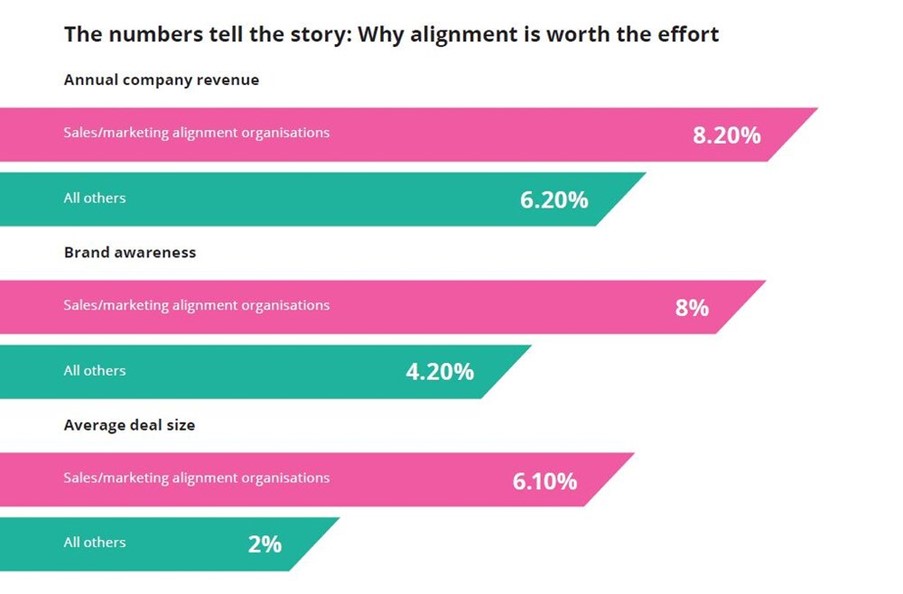Companies with “tightly aligned” sales and marketing departments reach 24% faster revenue growth and 27% quicker profit growth for three years.
When sales and marketing align, magic can happen. We know salestech and martech can help speed up your teams significantly, but without the foundations there, you'll not be living up to your full potential as a business.
As our resident salestech expert Frenci says: "SalesTech will never replace your marketing and sales team - People will buy from your story, not from your sales tools".

- Generate 32% higher revenue
- Retain 36% more customers
- Achieve 38% higher win rates
As Krista Neher, CEO at Boot Camp Digital said, “The key to success is understanding that sales and marketing are complementary – not competitive. Strong marketing supports sales teams.”
Alignment between the teams has increased in importance in recent years, due to the changes in consumer habits. So, the old sales technique no longer works. Sales are now part of the wider marketing mix with much of the purchase process happening online, with:
- 92% of buyers starting with an information search,
- 53% of buyers finding that going online and researching is superior to interacting with a salesperson,
- 75% of buyers depending on social networks to learn about choosing the right vendor,
- 90% of buyers refusing to take a cold call
So, before we jump into any more benefits, we need to understand the misalignment context? How can you tell whether your teams are aligned? What causes this alignment? How can you stop it from happening? Let's find out.
How can you tell if your marketing and sales teams are misaligned?
Well, keep an eye out for these sights creeping into your office:
- Your sales team begin to complain about "low quality" leads
- The salespeople disqualify a high percentage of MQLs immediately
- Customers aren't engaging with your ads, content, and emails despite an increase in ad spend and marketing budget
- Marketing collateral and resources go unused by the sales team
- Both teams operate independently most of the time
An analogy I’ve used for quite a while with marketing is fishing. If you’re a sales-driven organization, you just want to get out on the water and throw your lure. The more rods you have and the faster you can get them all in the water, the greater the chances that something will bite.
The problem is that the fish may not be where your boat is, may not like the bait you’re using, and as productive as you are—you may come home empty-handed.
What Causes Misalignment Between Sales and Marketing?
Number One: Lack of Understanding of Goals and Prospect Communication
Marketing managers can often lack an understanding of sales goals and communication approaches with prospects. This works the other way round, too.
In most companies, marketing is responsible for lead generation, which involves the analysis of data throughout the sales cycle. Then, the sales department is responsible for taking ownership of incoming leads and conversions.
But in aligned businesses, the teams can recognise that collaboration in all sales cycle activities can contribute to better goal achievement. Salespeople need good leads. So, they need marketing. But they need to help with this by inputting critical data for marketing to use in analytics.
Number Two: Lack of Defined Shared Terms and Internal Language
Sometimes misalignment can purely come from miscommunication. They might be talking about the same thing, with different terminology. So, you'll need to define:
- What is a lead?
- What defines an MQL?
- What defines an SQL?
According to the Unified Compliance Framework, there are multiple types of definitions, but two are most widely used:
- Intensional. Begin with the category, properties, or features shared by other concepts or things like it. Then, continue with what makes this concept or thing different from the other members of its category
- Extensional: List as many objects, properties, or features as necessary that represent the concept or thing being described. Then, explain how those objects, properties, or features fit into a more general category.
Number Three: Disconnection Between the Teams
As we've mentioned, the mandatory alignment between these two teams is a pretty modern idea. Previously, the benefits of collaboration weren't recognised or valued. This means that teams have been isolated, both in terms of their roles, as well as physically and functionally.
Without any formal connection, the teams carry out activities with little regard for what the other is doing. This can lead to redundancies in lead gen efforts or oversights in the development and execution of lead gen and sales process activities. Then, without any communication, these issues can go unnoticed and unreported.
So, your teams need to meet regularly, with an agenda which includes what's new, what's gone well, and what's gone wrong.
This disconnection can extend to how each team learns, too. The sales team might go to one event for training, team building, and motivational talks. The marketing team might go to a conference for demos and instructions. This means they're on completely different pages for their next steps.
This means the teams should learn together, in regular meetings or annual conferences, so they start on the best foot going forward.
What are the Benefits of Sales and Marketing Alignment?
First up, let's take a look at the numbers:
- 85% of marketers with an SLA think their marketing strategy is effective.
- Organisations with tightly aligned sales and marketing functions enjoy 36% higher customer retention rates
- 47% larger purchases result from nurtured leads than non-nurtured leads
- Companies with “dynamic, adaptable sales and marketing processes” report an average of 10% more salespeople on quota compared to other companies
- According to sales and marketing alignment stats, 56% of aligned companies meet their revenue goals. Furthermore, an additional 19% manage to beat their targets.
- Businesses with aligned sales and marketing teams experience a 36% higher customer retention.
- According to sales and marketing statistics, when both teams work in coordination, businesses see a 27% faster profit growth.
But there are plenty of day-to-day benefits of alignment, too. So, let's jump into our top 6 benefits of sales and marketing alignment. These are:
1. Clearer Mapping of the Customer Journey
Often businesses can have trouble understanding their buyer's perspectives, and struggle to break outside their own inside-out insight. But doing so is vital for any organisation to adopt an account-based marketing approach.
By removing the barriers between marketing and sales, you remove the funnel division, leading to a far more holistic view of the buyer journey from start to finish.
This mapping means you'll have access to a much more realistic and accurate understanding of the prospect's experience. This reduces the possibility of misunderstanding or misinterpretations of who is involved and in what ways, from the buyer's side. With this view, the two teams can define and execute campaigns designed to increase engagement with ease and confidence.
2. Improved Understanding of Your Ideal Customer
In organisations where sales and marketing aren't properly aligned, only 15% of companies collaborate on buyer personas. Contrast this with highly aligned companies, where 58% work together on buyer personas, according to CMI and LinkedIn research.
Usually, sales and marketing teams interact with buyers in different ways. This means they have a differing understanding of the customer. For example, marketers have a fuller understanding of buyer behaviour, whilst sales have more personal knowledge from closer buyer contact. So, it's important to combine these two and bring together these two types of knowledge.
Marketing is generally responsible for creating buyer personas, and gaining insights from websites and social media data, research and client interviews. But it's sales using this information daily to communicate with prospects and customers. On the other hand, sales know which pain points are bothering their prospects, what customers think of pricing, and who is quickest to close. By combining these insights, you'll gain a much better understanding of your customer.
3. Clearer and More Productive Feedback
Constant communication between sales and marketing leads to a more defined and stronger relationship.
From this improved communication you'll be able to see open lines of communication which create a chance to refine strategies and approaches.
It'll also mean that trust is developed between the two teams, which means they'll be more comfortable when asking the other team to make adjustments, and they'll also become more receptive and focused on their shared goals.
4. Increased Revenue
Sales and marketing alignment is potentially the biggest opportunity to grow your business; when they're united, there's a higher chance of achieving your goals like ROI and revenue. When the teams align, the sales cycle shortens, conversion rates improve, and revenue increases.
HubSpot has reported that misalignment between both sales and marketing teams costs a whopping $1T a year. This is mostly due to 79% of leads never converting into sales due to lack of nurturing. On top of this, 73% of the leads that end up being passed to marketing are never contacted.
Hubspot also found that organisations with excellent sales and marketing alignment close 38% more deals and achieve 27% faster three-year profit growth. They also gain 208% higher revenue.

5. Marketing Performance Improves
Alignment improves ROI because of its ability to shake up old, unproductive processes. For example, it means that marketers are able to be measured on their contribution to revenue, instead of just how many leads they churn out. This will encourage them to work deeper into the buyer's journey since they are participating in the entire process, which means they will care about the quality and fit of those leads.
Rather than ending their responsibility at leads, where they might not care about what happens when it's passed to sales, they'll be responsible for getting leads to close. This means they'll be more likely to follow the lead, communicate with the sales reps, and offer assistance.
Plus, when the marketer is involved in this process, their skill sets will improve. If they're jumping on calls with prospects, talking directly to them, instead of sending emails and putting out content, they'll get a much better sense of their audience's reactions. This will also lead to much better messaging.
6. Avoid the Blame Game
Okay, this is a good one. We all love to point fingers. And it's very easy to put the blame on the other team. With sales and marketing being separate, it provides the opportunity for each team to blame the other when lead generation and sales activities fail.
In fact, a common complaint from marketing is that sales reps are not playing their part in contributing data that is vital to high-quality lead generation.
On the other hand, the sales team often complains that marketing is not doing enough to attract the right types of leads to enable high-revenue conversions and long-term opportunities.
When these two teams are combined and aligned, however, it is impossible to place the blame on a specific team if something goes wrong - it means everyone has played a part. So, it can hold individuals to account to play ball, and work as a team.
